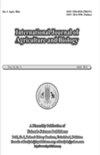亏缺灌溉和钾水平下不同冬小麦品种钾吸收、生理及分子响应
Q2 Agricultural and Biological Sciences
引用次数: 0
摘要
提高钾肥利用效率有利于谷类作物的可持续生产。以耐低钾品种科农9204和缺钾敏感品种吉麦120为对照,研究缺钾灌溉条件下钾肥投入水平对冬小麦吸收和农艺性状的影响。在高钾处理(K180、SK)下,两个品种的钾含量、钾积累量、生物量、上部膨大叶片光合参数(包括产量成分)基本一致。在缺钾(K60、DK)条件下,两个品种的钾相关性状、生理参数、生长性状和农艺性状表现出不同的行为;但科农9204的应答效果好于冀麦120。上述结果表明,低钾耐蚀品种在节水和亏缺灌溉条件下发挥着重要作用。钾转运蛋白(HAK)家族的两个基因TaHAK3和TaHAK5在缺钾胁迫下的表达量显著上调,且在缺钾胁迫下的克农9204植株中转录量明显高于冀麦120植株。对HAK基因的转基因分析证实了它们在低钾条件下调控植物钾积累和生物量生产中的积极作用。这些结果表明,不同的HAK家族基因在低钾条件下受钾剥夺信号的转录调控,并参与植物对钾的吸收和生物量生产。本研究表明,在节钾和节水条件下,不同冬小麦品种对钾的吸收和生物量产生了巨大的遗传变异,这与调节植物对钾的吸收和生长发育的不同HAK基因的转录效率有关。©2021朋友科学出版社本文章由计算机程序翻译,如有差异,请以英文原文为准。
Potassium Uptake, Physiological and Molecular Responses in Different Winter Wheat Cultivars under Deficit Irrigation and Potassium Levels
Improving potassium (K) use efficiency (KUE) is beneficial for the sustainable production of cereal crops. In this study, the effects of K input level on its uptake and agronomic trait of the winter wheat under deficit irrigation were investigated in K deprivation responses, using two cultivars contrasting (low-K tolerant cultivar Kenong 9204 and K deprivation sensitive one Jimai 120). Under sufficient-K treatment (K180, SK), the two cultivars showed similar K contents, and K accumulation, biomass, photosynthetic parameters in upper expanded leaves, including yield components. Under deficient-K (K60, DK) condition, both cultivars showed varied behaviors of the K-associated traits, physiological parameters, growth and agronomic traits; however, better response was observed in Kenong 9204 than Jimai 120. These results suggested the essential roles of low-K tolerant cultivars under the K-saving management together with deficit irrigation. Two genes of the potassium transporter (HAK) family, TaHAK3 and TaHAK5, showed expression of significantly upregulated upon K deprivation, with much more transcripts shown in the K-deprived Kenong 9204 plants than Jimai 120 ones. Transgene analysis on the HAK genes validated their positive roles in modulating the K accumulation and biomass production of plants under low-K condition. These results indicated that distinct HAK family genes are transcriptionally regulated underlying K deprivation signaling and contribute to plant K uptake and biomass production under low-K conditions. This study suggested the drastically genetic variation on K uptake and biomass production across winter wheat cultivars treated by K- and water-saving conditions, associated with transcription efficiency of the distinct HAK genes which modulate K uptake, growth and development of plants. © 2021 Friends Science Publishers
求助全文
通过发布文献求助,成功后即可免费获取论文全文。
去求助
来源期刊

International Journal of Agriculture and Biology
AGRICULTURE, MULTIDISCIPLINARY-
CiteScore
1.70
自引率
0.00%
发文量
40
审稿时长
5 months
期刊介绍:
Information not localized
 求助内容:
求助内容: 应助结果提醒方式:
应助结果提醒方式:


